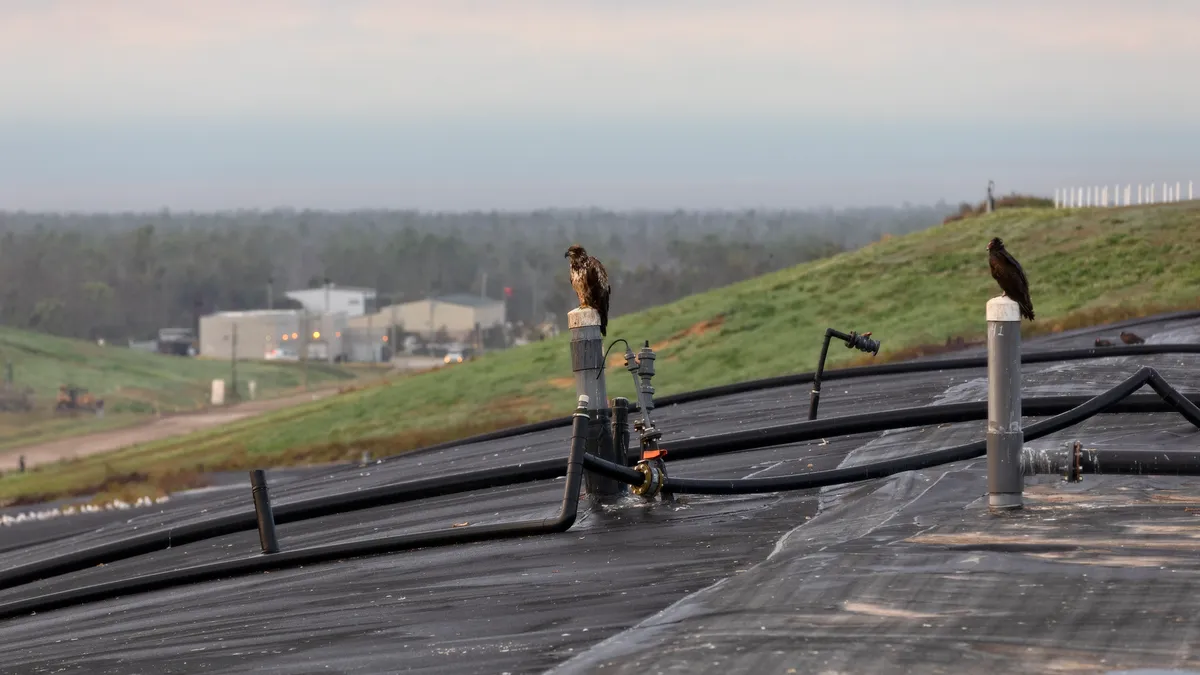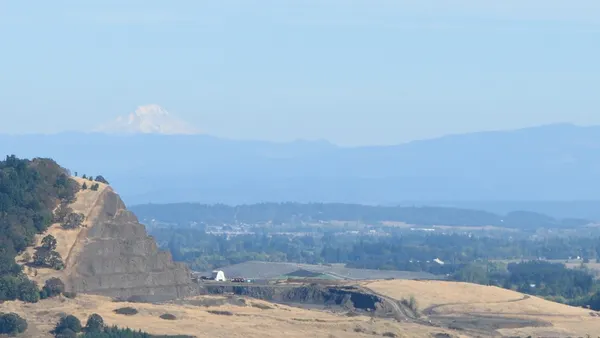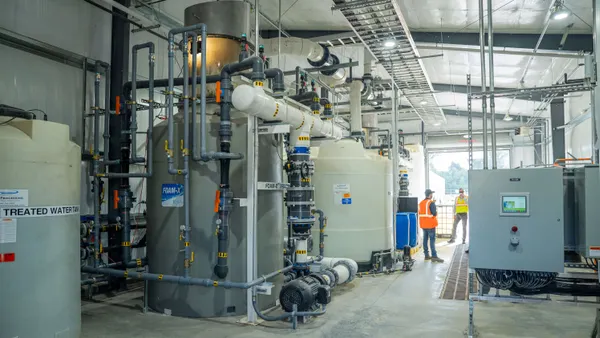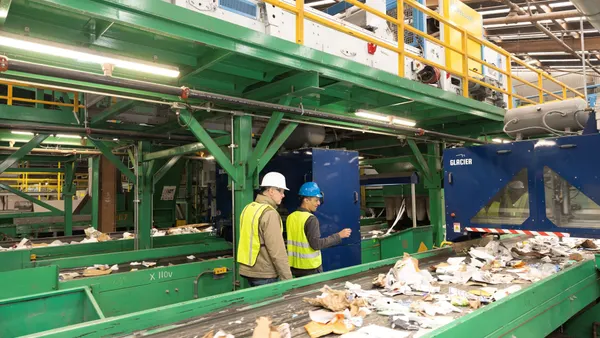The California Air Resources Board is soliciting feedback on an update to its Landfill Methane Regulation for the first time since it was adopted in 2010, looking to shave an additional 10% off landfill emissions through improved technology and tighter rules.
The proposed updates range from procedural to operational. CARB is looking to standardize the process used to gain approval for new methane tracking technology, improve best practices for landfill covers and encourage more beneficial uses for captured gas, among other changes.
The changes come as California officials have broadly ratcheted up efforts to address methane emissions. The UN’s Intergovernmental Panel on Climate Change has determined that mitigating the pollutant is an important focus area due to its potency as a warming agent in the atmosphere. But reducing its release from landfills requires accurate modeling, something that the U.S. EPA and state agencies have struggled to implement.
More action has occurred on landfill methane emissions in California, where CARB has partnered with NASA’s Jet Propulsion Laboratory and other groups since 2016 to study better emissions detection technology, including drones and satellites. WM, which has landfills in California, has also studied the technology as it looks to better understand its landfill emissions.
A May 18 virtual workshop to discuss potential changes to the LMR also occurred at the same time that a bill that would have required CARB to consider and implement the use of methane remote sensing data for landfills by 2026 died in committee, said Nick Lapis, director of advocacy for Californians Against Waste, in an interview.
"It’s actually kind of a best case scenario," Lapis said. "They always had the authority to do it, it was just a question of whether or not they were going to do it."
The state has also allocated $100 million to launch methane-detecting satellites, according to CARB, and the agency expects its first two satellites to be deployed this year. Carbon Mapper, a nonprofit spinoff of NASA's Jet Propulsion Laboratory that uses advanced technologies to track methane emissions, is hoping to partner with the state agency to deploy the satellites.
Daniel Cusworth, a project scientist with Carbon Mapper, said it "makes a lot of sense" for CARB and private landfill operators to seek greater use of advanced technologies like satellites or drones given pilot projects over the course of several years have proven their utility.
CARB did not respond to a request for comment about how widely it wants to see remote sensing technology in use, but the agency is publicly exploring pathways to implementation. During the virtual workshop, Xiaochi (Joe) Zhou, an air resources engineer with CARB, said that while satellites wouldn’t be able to detect small leaks, “remote sensing technology has its advantages.”
“We think it is an exciting new technology to find and mitigate large leaks and to supplement existing monitoring efforts,” Zhou said.
The agency is proposing two changes to the LMR related to “next generation emissions monitoring technology.” The first would require landfill operators to conduct ground monitoring and mitigation when they’re notified that a methane leak is detected via technologies such as satellites. The second would set up a standardized process for operators to get new technologies approved for use in monitoring
Those proposals come after studies conducted by Carbon Mapper and others, Cusworth said. Coming up with regulations related to emerging technologies can be a “chicken and egg” issue where the more the technology is implemented, the more regulators can understand how the technology can be most effectively used. Creating a pathway for those emerging practices to be adopted without limiting use cases can be key to more widespread adoption, Cusick said.
"Different types of technology are very well suited for specific types of use cases,” Cusick said. “How that gets integrated into a regulatory framework is very important.”
During the webinar, David Rothbart, a section manager with the Los Angeles County Sanitation Districts, said the entity had also been looking into drones and "other sensing devices." He said LACSD feels that drones are best used to identify hotspots while handheld devices are brought in for a more precise emissions measurement and to determine if remediation is successful.
Lapis said during the workshop that his organization was eager to see drones incorporated more often into emissions monitoring, noting that in addition to identifying leaks the technology is also useful for monitoring steep slopes and other areas at much greater frequency than hand monitoring.
Landfill covers
Workshop attendees also discussed the potential for emissions reductions via change in landfill cover practices. A chart from a 2020 Cal Poly study shared by CARB showed substantial difference between the amount of emissions released when daily covers, intermediate covers or final covers are used on a landfill cell, and the agency determined that "reducing the area and duration of daily cover is a promising strategy for reducing emissions."
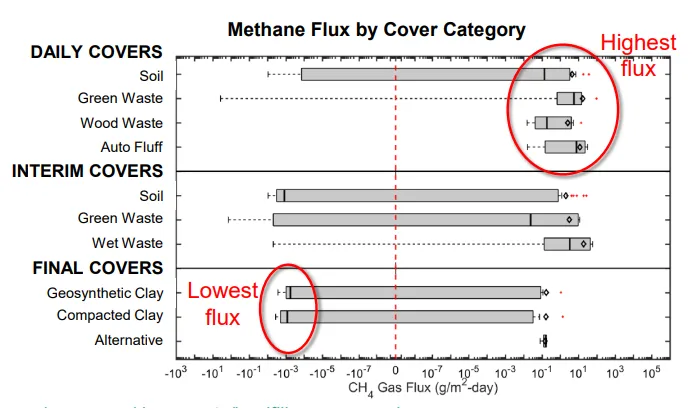
Lapis agreed with CARB scientists that there was potential in adjusting cover rules, noting that when the LMR was first introduced, the pattern in which landfills were filled was a key factor in how operators determined which cover to use. Specifically, some operators would keep multiple cells open at a time as they were filled, using more porous daily or interim covers in the process. Lapis proposed a discussion about shifting those patterns to fill up just one cell at a time before capping with a final cover and moving onto the next cell, thereby maximizing the amount of landfill covered by the least porous material.
But others noted that while there are clear differences in the emissions coming from each kind of cover, part of the motivation behind current filling practices was financial — purchasing and placing a final cover is a big expense that can be difficult for some landfill operators to meet.
"The question that’s being raised because of this is how much can we encourage closing slopes as you go up or regulating the placement of interim covers more frequently," said Bob Healy, a senior waste management engineer at CalRecycle. "We need input from operators because we need to do the right thing that's operationally satisfactory for a majority of the group."
Beneficial uses
In their presentation, CARB scientists estimated roughly two-thirds of landfill gas collected statewide is currently flared and identified 30 to 50 landfills that it believes capture enough methane to “cost-effectively utilize gas for energy generation.”
The agency said it was seeking comments on the barriers that prevent more landfill operators from reusing captured gas instead of flaring it. Currently, some landfills in the state have landfill-gas-to-electricity or renewable natural gas projects, but the use of such technologies is not universal.
Anthy Alexiades, a methane reduction strategies specialist with CARB, said the agency is interested in exploring partnerships with industrial facilities or anaerobic digesters that could be powered by the methane nearby landfills produce. Some experts in the workshop noted that encouraging beneficial uses for methane would be difficult in light of California’s SB 1383 directing methane-generating organics to be diverted from landfills, but Alexiades disagreed.
“When we’re of course looking across the entire state, those reductions from decreased organics disposal are really going to take a while,” Alexiades said. “The conclusion that we came to [in our scoping plan ... is that even if we stopped, completely phased out landfilling of organic waste today, we would still have these continued significant emissions from the waste that’s already in place in landfills for many decades in the future.”
CARB scientists said they would continue to solicit feedback on practices from landfill operators going forward. Looking further ahead, the agency is also considering other advancements including continuous emissions monitoring technology. CARB is currently determining where and how to pilot that technology "at a very small scale."
CARB’s Zhou said the process for updating the LMR could take a year, and anticipated the earliest an update could be implemented is 2025.



